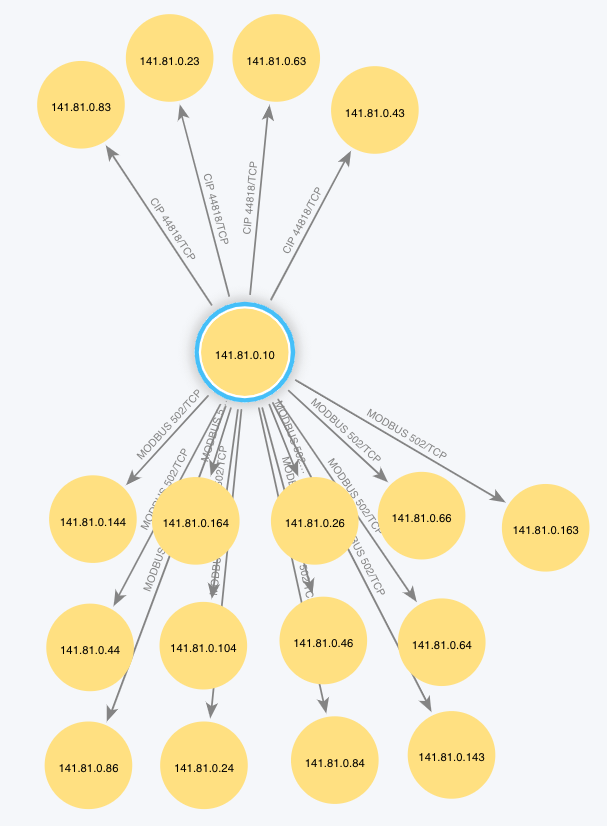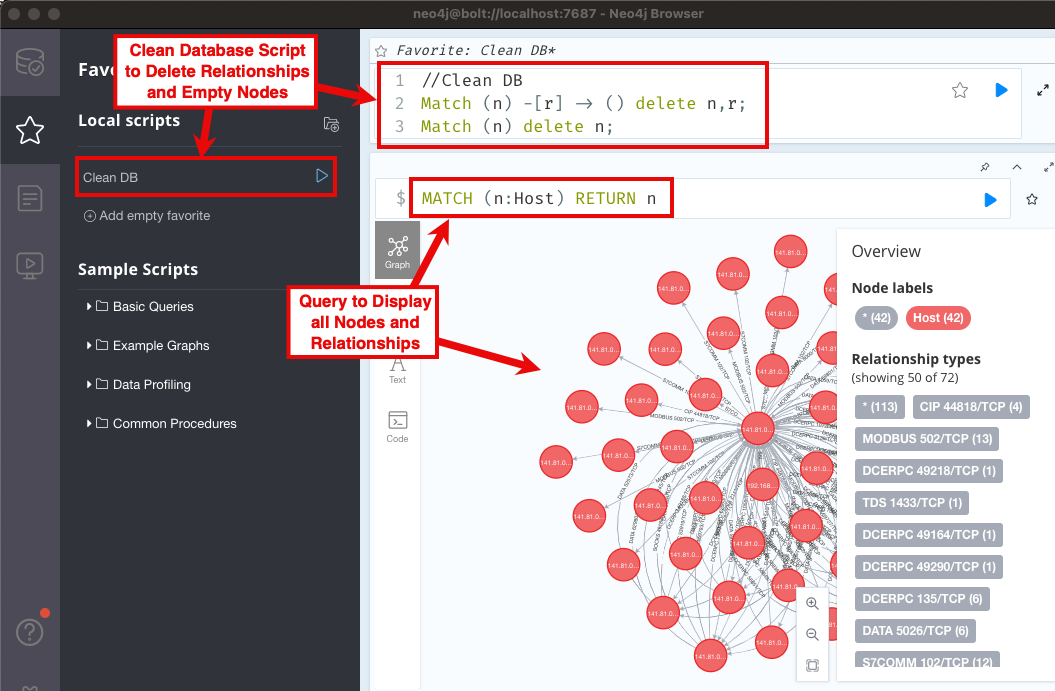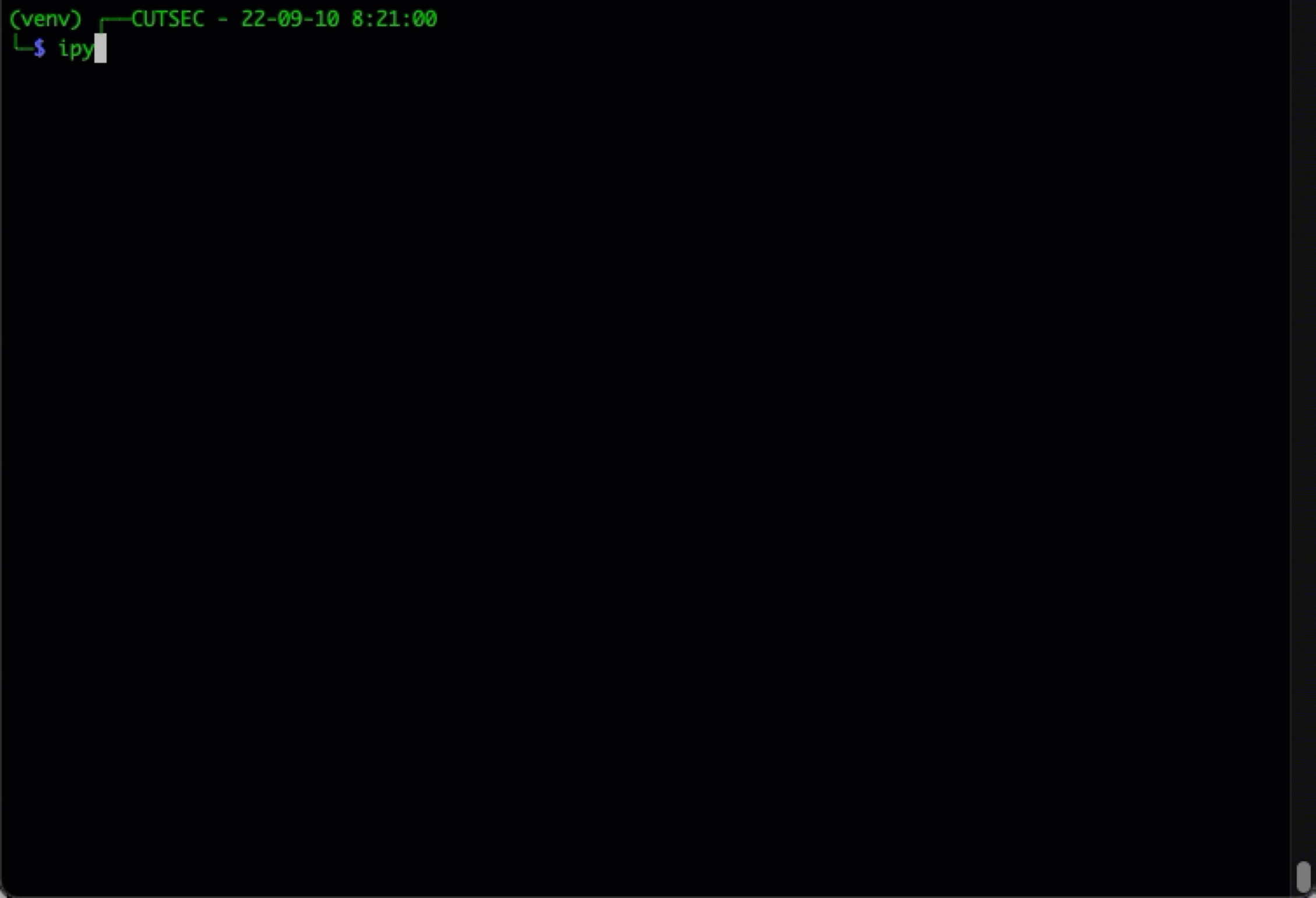A packet capture visualizer for industrial control networks. This project takes a network packet capture file (PCAP), processes the packets using pyshark, and sends information about the traffic to a Neo4j database. The Neo4j browsers and tools can be used to visualize and interact with the network information collected from the PCAP.
Visualization of network communications provides with the development and review of network and data flow diagrams. This tool uses the local network traffic to generate these diagrams while also providing details about the true nature of communications. Visualizing the network traffic can help identify instances of shadow, or even rogue, systems and devices.
IMPORTANT NOTE: You will need to learn how to use Neo4j to manually process this information. Populating the database is only the first step. There is more work once the script has completed. Don't be scared.
┌──CUTSEC - 22-09-09 17:54:20
└─$ ./icsPcapViz.py -f ./Plant1.pcap
┌──CUTSEC - 22-09-09 17:56:40
└─$ ./icsPcapViz.py -f ./Plant1.pcap -u
┌──CUTSEC - 22-09-09 17:59:23
└─$ ./icsPcapViz.py -f ./Plant1.pcap -t -u
NOTE: These nodes were manually organized.
- Install Neo4j: https://neo4j.com/docs/operations-manual/current/installation/
- Neo4j Quick Start: https://neo4j.com/developer/get-started/
- Neo4j Bloom Quick Start: https://neo4j.com/docs/bloom-user-guide/current/bloom-quick-start/
- Stop any running databases.
- Create a new project and name the project 'ICSPcapViz' or something related to your task.
- Add a new database and name it 'ICSPcapViz' or something related to your task.
- When prompted set the password to 'admin' (the ICSPcapViz default) or you will need to proved the password to the script.
- Start database.
- Open the Neo4j browser for the database.
- Create a script to clear the database, see below. - you may do several runs, this script will help.
// Clean DB
// Remove all node relationships
Match (n) -[r] -> () delete n,r;
// Remove all remaining nodes
Match (n) delete n;
- Run the 'ICSPcapViz' script
- Check database contents using the Neo4j browser with the query
MATCH (n) RETURN n - Use the Neo4j Bloom browser to review the data
- Select
HOST---HOST - Move nodes around
- Search for specific nodes or relationships
- Export data
- Export an image (visualize) the network
- Select
./icsPcapViz.py: 0.2.0
./icsPcapViz.py [-h] [-d] [-n int] [-l int] [-s int] [-m] [-M list] [-e] [-z] [-f <binary file>]
-h: This is it.
-v: version info.
-d: Turn on debugging. Default: off
-f <pcap>: pcap file that contains the data. Required
-p: <passwd>: Neo4J password Default: admin. Yes, this will be in your shell history.
-t: Process TCP packets. Default: True
-u: Process UDP packets. Default: False
-i: Process ICMP packets. Default: False [NOT IMPLEMENTED]
-a: Process ARP packets. Default: False [NOT IMPLEMENTED]
Be sure to start your Neo4J database. Read README for guidance.
Processing PCAPs can take time. Be patient.
Yes, you can write a progress bar and submit a pull request.
- Clone repository
- Change directory into the repository
- Install requirements using
pip install -r requirements.txt
- ControlThings Industrial Protocol PCAPS
- Plant1 - network traffic from a manufacturing plant which contains MODBUS, ENIP/CIP, Profinet, and other protocols
- CounterHack Holiday Hacking Challenge 2013 - network traffic with a lot of hosts, includes MODBUS traffic (can you find it using Neo4j Bloom?)
- ITI Industrial PCAPs
- Plant1 - network traffic from a manufacturing plant which contains MODBUS, ENIP/CIP, Profinet, and other protocols
Here are some helpful hints to help with packet parsing and protocol layers using PyShark.
Use the following code block in iPython to output the layers for each packet. More advanced searches can be performed by using filtering.
import os,sys,re
import pyshark
inf = "./Plant1.pcap"
#inf = "./sansholidayhack2013.pcap"
packets = pyshark.FileCapture(inf)
num_packets = 10
cnt = 0
for p in packets:
print(p.layers)
cnt = cnt +1
if cnt == num_packets: break
- Add property information to the nodes to include data like interface hardware addresses and vendors
- Colorize nodes to help with display in Neo4j browser
- Determine if nodes can be automatically organized by Neo4j browser
- Add ICMP processing
- Add ARP processing
Thank you to the following people for their help, input, and testing.
- CutSec Discord
- Tom Liston
- John H. Sawyer
- multiplex3r/loadPcap.py - great starting point using SCAPY
- NetFrenzy
- Packet Communication Investigator
- PCAP Visualization Tool


